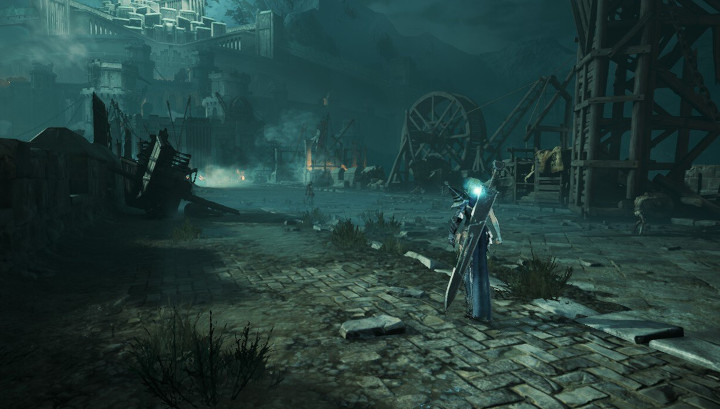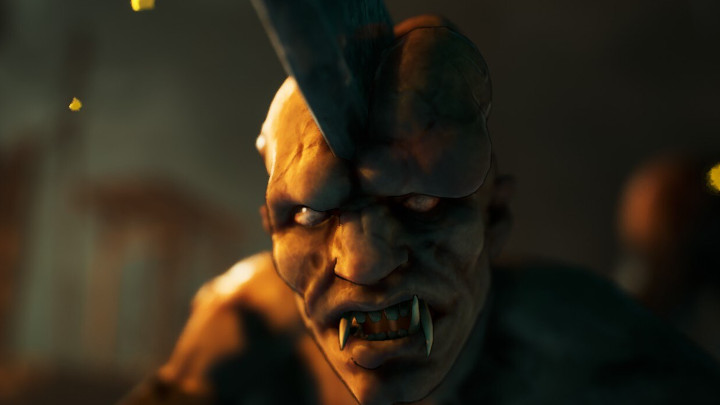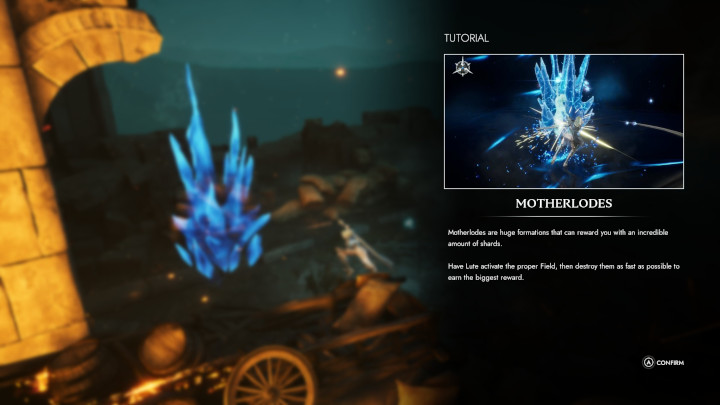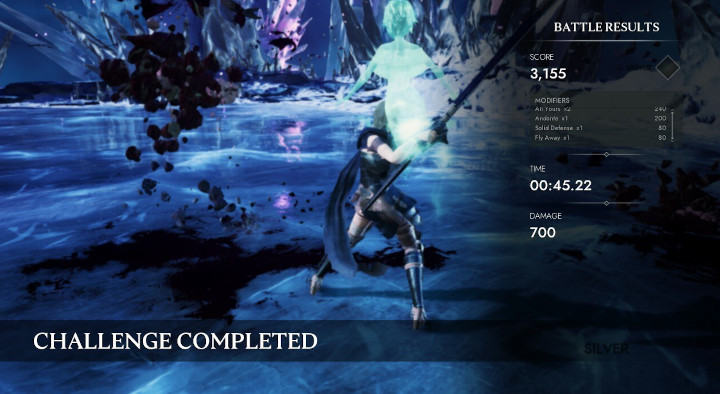
The hack-‘n-slash genre isn’t one that I gravitate toward all that often. Especially with so many series from the past couple of decades placing more of an emphasis on insane combo strings and lightning-fast reflexes, like Devil My Cry, Bayonetta and even the classic Ninja Gaiden series. I’ve just never had the laser-focused attention span to read enemy tells, let alone the ability to parry and rack up million-plus-hit combos.
I personally harken back to classics like the original God of War series, which relied heavily on combos, yes, but also how you navigate the battlefield in order to avoid damage and do a good bit of crowd control. And thankfully, after spending some time with the first two acts of Soulstice (thanks to a preview build provided by publisher Modus Games), I can say — at least in my experience — that it falls squarely in the classic God or War template rather than the template of games like Bayonetta.

In Soulstice you control Briar, who is accompanied by an astral wing-person named Lute. You are Chimeras sent to meet up with others of your warrior class in order to investigate the opening of a gate that seems to be threatening your realm. You’re basically a part of an elite squad of ass-kickers, albeit one that’s looked down on by other Chimeras. There are some tensions involving Lute and the rest of the squad that will no doubt be fleshed out as the game plays out, though my preview build ended before I could see these story threads fully wrapped up.
I was immediately struck by the art design of Soulstice. In his own preview coverage (based off an earlier build of the game) Half-Glass Gaming’s owner Josh mentioned that the levels were designed with an admiration for From Software titles. And I can see it. The looming, grandiose Gothic castle you make your way toward — and eventually infiltrate — definitely gives off Demon’s Souls vibes.
The character models of Briar and Lute are almost jarringly cartoony by contrast, with Lute resembling Casper the friendly ghost. This can be a bit distracting at times, but it is in keeping with the grotesque-yet-cartoony design of the grunts and foot soldiers you will be plowing through along this journey.

I will say that this was a demo build, and that I also played it on my Steam Deck. Although there were some initial stutters and jitters between cutscenes and live gameplay, and some awkward transitioning between the various areas of each stage, this could all be smoothed out before launch. These issues were also much worse earlier in my playthrough, and they seemed to get better the more I played, so this could all just be a shader compilation issue. Regardless, the experience wasn’t entirely smooth for me, but my issues didn’t crop up during combat or lead to any unfair deaths along the way.
Speaking of combat, Soulstice offers the classic two-hit-type combat approach. The Y button (or triangle, depending on your controller), is the light, quick greatsword Ashen Vindicator attack. The X (or square) button is your heavier Warhammer Ashen Enforcer. I also unlocked a gauntlet shield called the Hand of Retribution, which has a boxing or striking attack.

There is a sort of parry feature that requires you to press B (or circle) whenever the prompt appears on screen right before an enemy attacks, either at range or up close. Timing this button press correctly allows Lute to help deflect ranged attacks or even slow down closer enemies, opening them up for a couple of free blows by Briar. But this slowdown doesn’t always negate the incoming hit, especially with more brutish foes, so you’ll still need to get out of there before they resume their attack if you can’t dispatch them before they recover.
The left bumper allows Briar to dash around, and the left and right triggers are each tied to a special sort of spectral effect that Lute casts, forming a dome around the both of you that follows you as you move around. Outside of combat, the blue effect allows Briar to damage blue shards strewn about the levels. Once broken and the pieces collected, these shards feed into the currency you need to level up Lute’s abilities. It also allows for spectral platforms to become tangible, which will aid in platforming traversal.
The red field does the same for red crystals, which feeds into the currency used to upgrade Briar. While in battle, the blue field renders spectral enemies open to attack, although I have a feeling we’ll see more uses for this as we get deeper into the game.

For the most part, each level is broken up into smaller chunks with fixed camera perspectives, much like classic God of War or even Resident Evil, with the angle shifting as you progress through the various sections of the map. Once you reach an arena area and trigger enemies, you are then free to move the camera around in a more traditional third-person aspect, and you can also lock onto specific enemies and flick the right stick to switch between targets.
This all feels great, and combat is rarely outright frustrating or overly punishing. That could change, of course, as you get deeper into the game, especially as more enemy types get introduced and thrown at you in varying arrangements.
After each battle, you are scored based on how fast you were able to fell the enemy, how many hits you took, the number of combos, and other factors. I would often fluctuate between stellar and mediocre scores, so I’m not sure I completely acclimated to this system in my time with the game.
Additionally, there are portals littered around the game’s stages that will teleport the player to isolated arenas that have specific challenges that must be met in order to clear them. You might have to counter a certain number of times, for example, or finish within a specific time limit. These are completely optional, but they offer a nice little bit of challenge should you choose to engage with them.

Each level is chock full of barrels, tables, and other specific bits of scenery to smash through, giving you opportunities to fill you red currency meter. This feels like a game mechanic straight out of the early 2000s. But given my collector-focused mind and penchant for busywork, I found it impossible to not engage with these destructible items, often going out of my way to explore the otherwise admittedly linear level layouts in order to smash and grab everything I could.
But you aren’t just collecting shiny bits for the sake of collecting shiny bits. As I mentioned earlier, there is a skill leveling system for both Lute and Briar. Along your journey you will meet a pretentious jerk of a character named Layton, with his stupid Vega-esque mask and dickhole crow companion named Corvo. This schmuck will demean and belittle Briar and Lute to no end, but he serves as your skill and item vendor, so you will have no choice but to endure his snide comments and boorish attitude.
The leveling system is pretty much as one would expect, with offense and defense perks for Briar and astral skills and counter abilities for Lute. You can also purchase health aids using the red currency that feeds into Briar’s skill leveling, which will help you regain some health or even revive mid battle instead of back at a check point should you die mid-fracas.
Overall, there is a lot to like about Soulstice for both hack-‘n-slash enthusiasts and newcomers to the genre. I personally liked the almost throwback nature of some of the design elements and gameplay mechanics, which brought me back to a time when I gobbled these games up. And although it’s been almost two decades since I’ve really sunk my teeth into a game like this, I didn’t ever feel completely over my head with getting into Soulstice, even though at times some of the specific terminology could feel a bit foreign (though a lot of that eventually clicked for me).

I am curious to see if the full game can hold my attention once it launches on September 20, 2022. Considering how many bangers are on the horizon this year, hopefully Soulstice won’t get lost in the shuffle or land on my ever-growing backlog. Considering it ran and played pretty well on the Steam Deck, that alone will give it a leg up, considering how much of my gaming time has been dedicated to that little wunderkind of a console.